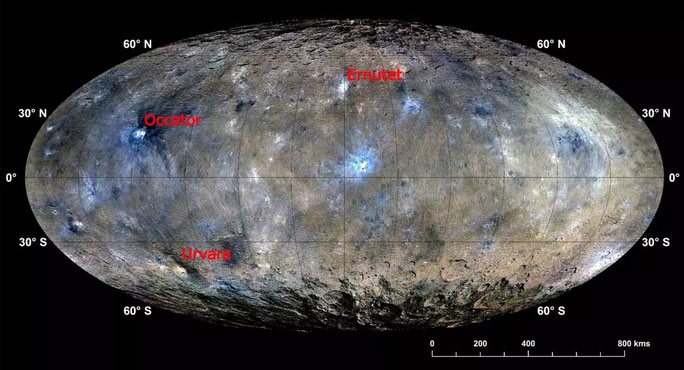Ceres: The Mysterious Dwarf Planet and Its Astonishing Discoveries
A recent study published in Nature Communications has revealed the presence of salt deposits and organic compounds in the third-largest impact crater on Ceres, along with signs of geological activity occurring at least once in millions of years after the object was formed.
Ceres is the only dwarf planet located within the asteroid belt between Mars and Jupiter, with a diameter of 960 km. For centuries, it was considered the eighth planet of the Solar System. However, with advances in astronomical techniques, scientists later determined that it is relatively small and classified it as a dwarf planet.

Map of Ceres – (Image: NASA/JPL-Caltech/UCLA/MPS/DLR/IDA)
Despite its classification, Ceres continues to astonish scientists with its well-preserved features in recent years. The most shocking discovery has been the traces of a subsurface ocean beneath its icy crust, as well as signs of geological activity. In planetary science, geological activity, which has only been confirmed on Earth and Jupiter’s moon Io in the Solar System, is considered one of the essential factors for life.
According to SciTech Daily, in this latest study, scientists from the Max Planck Institute for Solar System Research, the University of Münster (Germany), and the National Institute of Science Education and Research (NISER – India) focused on three impact craters.
The bright spots previously recorded by NASA’s Dawn spacecraft in the Occator crater turned out to be remnants of a briny layer beneath the surface, gradually rising through freezing processes until recent geological times.
In the Ernutet crater, they found evidence of very complex organic compounds, promising to provide valuable data about the origins of life in the Solar System.
The research also targeted Urvara in the Southern Hemisphere, the largest impact crater with a diameter of 170 km, which contains mountain ranges and various complex terrains. They also observed a combination of salt residues and unusual organic compounds on the western slope of the central mountains.
“The origin and formation of organic compounds on Ceres remain an intriguing open question, with significant implications for Ceres’ overall geological history as well as potential connections to astrobiology and the habitability of celestial bodies in the Solar System,” said Dr. Guneshwar Thangjam from NISER.


















































